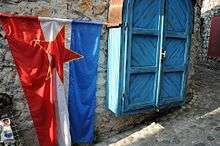Yugo-nostalgia
Yugo-nostalgia (Serbo-Croatian: југоносталгија / jugonostalgija, Slovene: jugonostalgija, Macedonian: југоносталгија) is a little-studied psychological and cultural phenomenon found among the populations of the former Yugoslavia, in the present-day Bosnia and Herzegovina, Croatia, Montenegro, North Macedonia, Serbia, and Slovenia. When used unironically, it refers to an emotional longing for a time past when the splintered states were a part of one country, a grief about the war that tore it apart, and a desire to again unite. Self-described "Yugonostalgics" may assert their grief that brotherly love, unity, and coexistence failed, while division and nationalism won, or they may assert that their quality of life was better.
.jpg)

While its anthropological and sociological aspects have not been extensively studied, it can also be used negatively and ethnocentrically to denigrate someone usually of the same ethnic background who expresses sympathy or statement of support for any aspect of Yugoslavia against the prevailing nationalist zeitgeist. [1]
Present cultural and economic manifestations of Yugo-nostalgia include music groups with Yugoslav or Titoist retro iconography, art works, films, theater performances, and many organized, themed tours of the main cities of the former Yugoslav republics. The notion of Yugo-nostalgia should not be confused with Yugoslavism which is the ideology behind the unity of South Slavic nations. The concepts have some overlap but Yugo-nostalgia celebrates the pre-1991 period whereas Yugoslavism and Yugoslav reunification (as a branch of pan-Slavism) are an ongoing mindset just as likely to appeal to persons born after the breakup of Yugoslavia that feel their national interests may be best served by unification.
According to a Gallup poll from 2017, 81% of Serbs think that the breakup of Yugoslavia harmed their country, while 77% of Bosnians and Herzegovinians and 65% of Macedonians agree. Only 4% of Serbs think that the break-up of Yugoslavia was beneficial for their country, while just 6% of Bosniaks and 15% of Montenegrins feel positive about the split. In Croatia, 55% of respondents saw the break-up as beneficial and just 23% as harmful. In Slovenia, 41% see the break-up as beneficial while 45% think it was harmful. The highest number of respondents who welcomed the break-up of Yugoslavia were in Kosovo which declared independence in 2008, where 75% said the split was beneficial and only 10% regretted it.[2]
Positive sense
In its positive sense, Yugo-nostalgia refers to a nostalgic emotional attachment to both subjective and objectively desirable aspects of the SFRY. These are described as one or more of: economic security, sense of solidarity, socialist ideology, multiculturalism, internationalism and non-alignment, history, customs and traditions, and more rewarding way of life.[3] As Halligan argues, such nostalgia effectively "reclaims" pre-1989 cultural artefacts, even propaganda films. These positive facets, however, are opposed to the perceived faults of the successor countries, many of which are still burdened by the consequences of the Yugoslav wars and are in various stages of economic and political transition. The faults are variously identified as parochialism, jingoism, corruption in politics and business, the disappearance of the social safety net, economic hardship, income inequities, higher crime rates, as well as a general disarray in administrative and other state institutions.[1]
Negative sense
In the negative sense, the epithet has been used by the supporters of the new post-dissolution regimes to portray their critics as anachronistic, unrealistic, unpatriotic, and potential traitors. In particular, during and after the Yugoslav wars, the adjective has been used by state officials and media of some successor countries to deflect criticism and discredit certain avenues of political debate. In fact, it is likely that the term Yugo-nostalgic was originally coined precisely for this purpose, appearing as a politically motivated pejorative label in government-controlled media, for example in Croatia, very soon after the breakup of the SFRY.[4]
According to Dubravka Ugrešić the term Yugo-nostalgic is used to discredit a person as a public enemy and a "traitor".[5][6]
Yugoslavism after Yugoslavia

By the breakup of Yugoslavia, the idea of Yugoslavism had lost popularity. Serbia and Montenegro continued a South Slavic union as the Federal Republic of Yugoslavia from April 1992 to February 2003, then renamed the country with the federal republics' individual names – Serbia and Montenegro. The number of self-declared "Yugoslavs" (in the ethnic sense) in the region reached an all-time low after the breakup of Yugoslavia. The former country's main language, Serbo-Croatian, is no longer the official language of any of the former state's constituent republics. There are few works published about the language, and it no longer has a standardizing body. The .yu Internet domain name, which was popular among Yugo-nostalgic websites, was phased out in 2010.
Yugo-nostalgia is seeing a comeback in the former Yugoslav states.[7] In Vojvodina (northern province of Serbia), one man has set up Yugoland, a place dedicated to Tito and Yugoslavia.[8][9] Citizens from former Yugoslavia have traveled great distances to celebrate the life of Tito and the country of Yugoslavia.[10]
In Croatia, the "Alliance of Yugoslavs" (Savez Jugoslavena) was established in 2010 in Zagreb, an association aiming to unite the Yugoslavs of Croatia, regardless of religion, sex, political or other views.[11] Its main goal is the official recognition of the Yugoslav nation in every Yugoslav successor state: Croatia, Slovenia, Serbia, North Macedonia, Bosnia and Herzegovina, and Montenegro.[12]
Another organization advocating Yugoslavism is the "Our Yugoslavia" association (Udruženje "Naša Jugoslavija") founded on 30 July 2009,[13] seated in Pula,[14] which is an officially registered organization in Croatia.[15] The association has most members in the towns of Rijeka, Zagreb and Pula.[16] Its main aim is the stabilisation of relations among the Yugoslav successor states. It is also active in Bosnia and Herzegovina, however, its official registration as an association was denied by the Bosnian state authorities.[15]
The probably best-known Yugoslavist organization in Montenegro is the "Consulate-general of the SFRY" with its headquarters in the coastal town of Tivat. Prior to the population census of 2011, Marko Perković, the president of this organization called on the Yugoslavs of Montenegro to freely declare their Yugoslav identity on the upcoming census.[17]
Yugoslav reunification
_location_map.svg.png)
Yugoslav reunification refers to an idea of reunification of some or all of the six republics. Despite a grassroots appeal across the former territory, its proponents are resigned to the notion that such a state is not likely to come into fruition since the successor regimes have firmly cemented their commitment to an independent existence, having established their institutions and chosen their respective directions.[18]
See also
- Yugoslavism
- Titoism
- Balkanization
- Yugoslavs
- Communist nostalgia, similar phenomena elsewhere
- Tito's Blue Train
- Ostalgie
References
- Nicole Lindstrom, Review essay on: "Yugonostalgia: Restorative and Reflective Nostalgia in Former Yugoslavia."
- "Many in Balkans Still See More Harm From Yugoslavia Breakup". Gallup. Retrieved 28 September 2019.
- Brenda Luthar and Marusa Puznik, Remembering Utopia: The Culture of Everyday Life in Socialist Yugoslavia. Washington, DC: New Academia Publishing, 2010
- http://mams.rmit.edu.au/wcch64c2r40r.pdf
- Ugrešić, Dubravka (1998). The Culture of Lies: Antipolitical Essays. Pennsylvania State University Press. p. 231. ISBN 0-271-01847-X.
- Müller, Jan-Werner (2002). Memory and Power in Post-War Europe: Studies in the Presence of the Past. Cambridge University Press. p. 12. ISBN 0-521-00070-X.
- Telegraph (29 December 2007). "Many in Slovenia yearn for old Yugoslavia". The Daily Telegraph. London. Retrieved 21 May 2010.
- https://www.youtube.com/watch?v=MRASojQfNWI
- BBC (10 May 2004). "Nostalgic Yugoslav re-creates land of Tito". BBC News. Retrieved 21 May 2010.
- BBC (23 May 2008). "Ex-Yugoslavs pine for unity and dignity". BBC News. Retrieved 21 May 2010.
- U Zagrebu osnovan Savez Jugoslavena (in Croatian). Jutarnji list. Portal Jutarnji.hr; 23 March 2010
- U Zagrebu osnovan Savez Jugoslavena: Imamo pravo na očuvanje baštine Jugoslavije (in Croatian). Index.hr. L.J.; 23 March 2010
- Osnovano udruženje "Naša Jugoslavija" u Puli (in Serbian). Radio Television of Vojvodina. Tanjug; 30 July 2009
- Udruženje "Naša Jugoslavija" osniva Klubove Jugoslavena Archived 2012-04-01 at the Wayback Machine (in Croatian). Dubrovački vjesnik. Silvana Fable; 25 July 2010
- Yugoslavs in the twenty-first century: ‘erased’ people openDemocracy.net. Anes Makul and Heather McRobie; 17 February 2011
- "Naša Jugoslavija" širi se Hrvatskom (in Serbian). Vesti online. Novi list; 27 July 2010
- Perković pozvao Crnogorce da se izjasne i kao Jugosloveni Archived 5 April 2011 at the Wayback Machine (in Serbian). Srbijanet. 03-03-2011
- Bilefsky, Dan (January 30, 2008). "Oh, Yugoslavia! How They Long for Your Firm Embrace". The New York Times. Retrieved March 16, 2015.
Bibliography
- Halligan, Benjamin: "Idylls of Socialism: The Sarajevo Documentary School and the Problem of the Bosnian Sub-proletariat". In Studies in Eastern European Cinema (Autumn 2010). (http://usir.salford.ac.uk/11571/3/visualrecollectivisationpostcopyedit.pdf)%5B%5D
- Breda Luthar; Maruša Pušnik (2010). Remembering Utopia: The Culture of Everyday Life in Socialist Yugoslavia. New Academia Publishing, LLC. ISBN 978-0-9844062-3-4.
- Trovesi, Andrea: L'enciclopedia della Jugonostalgija. In Banchelli, Eva: Taste the East: Linguaggi e forme dell'Ostalgie, Sestante Edizioni, Bergamo 2006, ISBN 88-87445-92-3, p. .
- Djokić, Dejan (2003). Yugoslavism: Histories of a Failed Idea, 1918-1992. C. Hurst & Co. Publishers. ISBN 978-1-85065-663-0.CS1 maint: ref=harv (link)
- Volcic, Zala, "Yugo-Nostalgia: Cultural Memory and Media in the Former Yugoslavia," Critical Studies in Media Communication, Volume 24, Number 1, March 2007: 257-274
- Kristen R. Ghodsee, "Red Nostalgia? Communism, Women's Emancipation, and Economic Transformation in Bulgaria."
- Bošković, Aleksandar (2013). "Yugonostalgia and Yugoslav Cultural Memory: Lexicon of Yu Mythology". Slavic Review. 72 (1): 54–78. doi:10.5612/slavicreview.72.1.0054.
External links
- The Independent (1 March 2008). "Bringing back Tito". London. Retrieved 21 May 2010.
- NPR (9 October 2006). "'Yugonostalgia' Takes Hold in Slovenia". Retrieved 21 May 2010.
